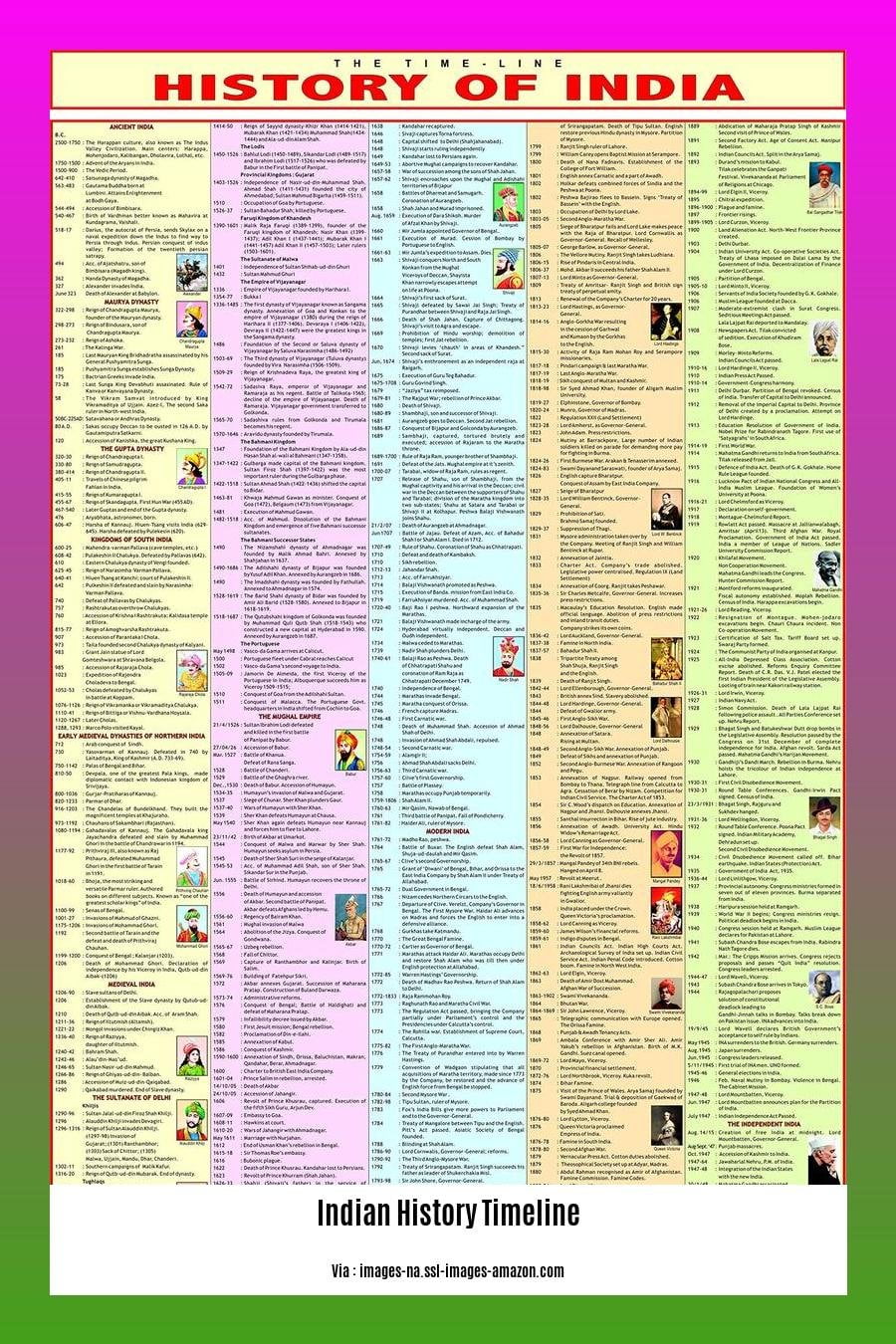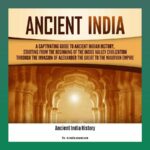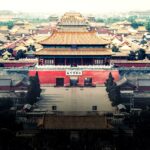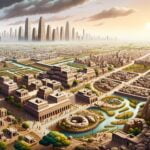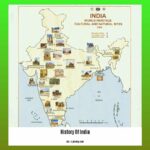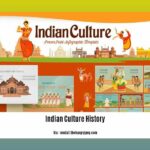Embark on an extraordinary journey with “A Comprehensive Overview: Indian History Timeline.” This insightful article unveils India’s captivating past, from its ancient roots to its modern-day achievements. Each chapter meticulously unravels significant events, empires, and cultural influences that have shaped the nation’s unique identity. Prepare to be immersed in an epic saga that weaves together the threads of time, connecting the dots of India’s rich history for a deeper understanding of its present and future.
Key Takeaways:
- Ancient India (3300-500 BCE): Harappan Civilization flourished, and the Vedic Age emerged.
- Gupta Empire and Fragmentation (280-750 CE): Indian culture reached its golden age, with the rise of Buddhism and Jainism.
- Chola Empire and Medieval India (753-1190): Trade and cultural influence expanded in South and Southeast Asia.
- Muslim Rule in India (1206-1490): Delhi Sultanate and Mughal Empire dominated India.
- British Raj in India (1799-1943): Britain colonized India, leading to the Indian independence movement.
A Comprehensive Overview: Indian History Timeline
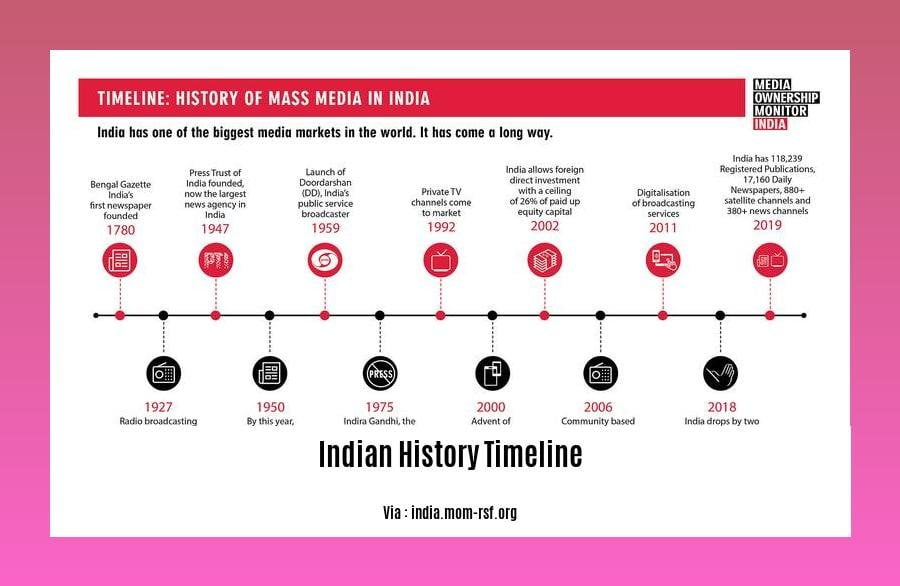
Ancient India (3300-500 BCE)
India’s ancient history is a tapestry of civilization, culture, and religious transformation. The Harappan Civilization, located in the Indus Valley, flourished between 3300-1900 BCE. Known for its advanced urban planning, the Harappans made significant contributions to architecture, metallurgy, and trade. Subsequently, the Vedic Age (1500-500 BCE) marked the rise of Vedic literature, including the Vedas, which laid the foundation for Hinduism and Indian philosophy.
Gupta Empire and Fragmentation (280-750 CE)
The Gupta Empire, established in 280 CE, is often considered the golden age of Indian history. This period witnessed tremendous cultural and intellectual achievements. Hinduism and Buddhism flourished, and renowned scholars like Kalidasa and Aryabhata made immense contributions to literature, art, and science. However, after the Gupta dynasty’s decline, India entered a period of political fragmentation.
Chola Empire and Medieval India (753-1190)
The Chola Empire, based in South India, rose to prominence in the 9th century CE. Under the Cholas, South India experienced economic prosperity and cultural growth. Their empire extended across vast territories, including parts of Southeast Asia. The period witnessed the construction of magnificent temples and the spread of Tamil literature.
Muslim Rule in India (1206-1490)
The Indian history timeline took a turn with the establishment of the Delhi Sultanate in 1206 CE. The Sultanate introduced Islamic rule to India, influencing architecture, administration, and cultural exchange. The Mughal Empire, founded by Babur in 1526 CE, marked a significant period of Islamic rule. The Mughals patronized the arts and expanded their empire across vast parts of the Indian subcontinent.
British Raj in India (1799-1943)
The British East India Company’s growing influence in India eventually led to the establishment of colonial rule in 1799 CE. The British introduced administrative reforms, infrastructure development, and educational systems that impacted Indian society. However, British rule also brought economic exploitation, political subjugation, and the rise of the Indian independence movement.
Indian Independence and Modern India (1947-Present)
India gained independence from British rule in 1947, marking a new era of self-governance. The first Prime Minister, Jawaharlal Nehru, initiated a modern nation-building process that included economic planning, social reforms, and the pursuit of a non-aligned foreign policy. India has since witnessed significant economic growth, technological advancements, and a vibrant democratic system while navigating challenges of poverty, inequality, and communal tensions.
Discover the rich tapestry of India’s past from ancient civilizations to modern times in the comprehensive history of India section. Explore the fascinating history of ancient India, unraveling its empires, dynasties, and cultural heritage in ancient India history. Delve into the vibrant Indian culture history, exploring its diverse traditions, art, music, and customs.
Mughal Empire and the Golden Age of India
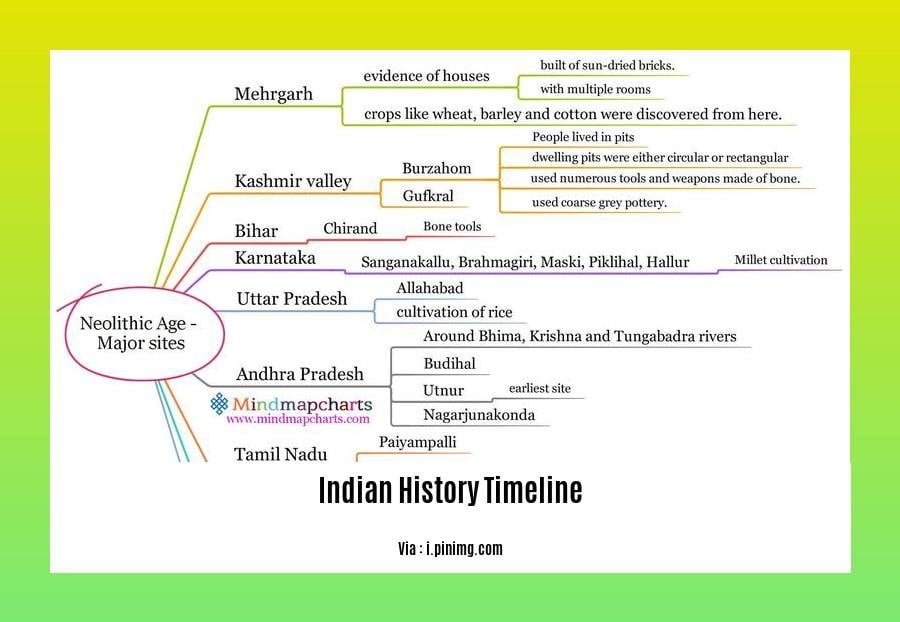
The Mughal Empire, founded in 1526 by Babur, marked a significant era in Indian history, renowned as the Golden Age. Spanning from 1526 to 1857, the empire stretched across most of northern and central India, extending its influence over present-day Pakistan.
Akbar, one of the most influential Mughal emperors, reigned from 1556 to 1605. Known for his administrative reforms and diplomatic skills, Akbar solidified the empire by introducing religious tolerance and incorporating Hindu nobles into his government.
The Mughal Empire reached its peak under Aurangzeb, who ruled from 1658 to 1707. During his reign, the empire expanded to its greatest extent, encompassing almost all of the Indian subcontinent. Aurangzeb’s patronage of the arts and architecture gave rise to magnificent structures such as the Taj Mahal.
Key Takeaways:
- The Mughal Empire was a significant period in Indian history, spanning from 1526 to 1857.
- Akbar and Aurangzeb were two of the most notable Mughal emperors, known for their contributions to the empire’s consolidation and expansion, respectively.
- The Mughal Empire’s Golden Age witnessed advancements in art, architecture, and religious tolerance.
- The empire declined after Aurangzeb’s death due to internal conflicts and external pressures.
Most Relevant URL Source:
- Britannica:
Colonial India: British Raj and the Struggle for Independence
The British Raj emerged in 1858 as a period of British rule that reshaped the Indian subcontinent. Let’s dive into this era:
- Sepoy Mutiny (1857): Disgruntled Indian soldiers (sepoys) revolted against British rule, leading to widespread unrest.
- Direct British Rule: The East India Company’s reign ended, and India came under the direct control of the British Crown.
- Administration Overhaul: British officials overhauled the Indian administration, establishing new laws, policies, and infrastructure.
- Economic Impact: British rule spurred economic growth in some sectors while exploiting India’s resources for their own benefit.
The Struggle for Independence
Indians relentlessly resisted British rule, fueled by a growing sense of nationalism:
- Indian National Congress (1885): A prominent political organization emerged, advocating for self-rule.
- Nonviolent Resistance: Mohandas Gandhi emerged as a leader, promoting nonviolent civil disobedience.
- Salt March (1930): Gandhi led a mass protest against British tax on salt, sparking widespread civil disobedience.
- World War II and Independence: India’s support during the war weakened British power, leading to independence in 1947.
Key Takeaways:
- The British Raj profoundly impacted India’s political, economic, and social landscape.
- Indian resistance to British rule was multifaceted, including political movements, civil disobedience, and armed resistance.
- The struggle for independence shaped India’s national identity and laid the foundation for modern India.
Most Relevant URL Source:
Modern India: Independence and Challenges
Key Takeaways:
- India gained independence from British rule.
- The partition led to the creation of India and Pakistan.
- Mahatma Gandhi was a key figure in India’s freedom movement.
- Post-independence India has faced challenges such as poverty and communal tensions.
India’s Struggle for Independence
India’s independence movement was a long and arduous struggle against British rule. The Indian National Congress (INC), founded in 1885, played a pivotal role in organizing and mobilizing the masses. Mahatma Gandhi, a charismatic leader, emerged as the face of the movement and advocated for nonviolent civil disobedience.
The Partition of India
Independence came in 1947, but it was accompanied by the partition of India into two nations: India and Pakistan. This division triggered one of the largest mass migrations in history, displacing millions of people and leaving behind deep scars.
Challenges of Independent India
Post-independence India has faced significant challenges, including:
- Economic Disparities: India has made great strides in economic growth, but poverty and inequality remain major issues.
- Communal Tensions: Religious and ethnic conflict have marred India’s journey as an independent nation.
- Political Instability: Regionalism, corruption, and political violence have undermined democratic governance.
Despite these challenges, Modern India is a vibrant democracy with a rich cultural heritage. Its people strive to build a more equitable and prosperous future, drawing inspiration from the resilience and sacrifices of their ancestors.
Citation:
Cultural India. (n.d.). History of India’s Independence. History of India’s Independence – Timeline of Freedom Struggle’s Important Movements.
FAQ
Q1: What is the significance of the Gupta Empire in Indian history?
Q2: How did the Chola Empire contribute to the spread of Indian culture and trade?
Q3: What were the major milestones in the Mughal Empire’s rise and decline?
Q4: How did the British Raj impact the political and economic landscape of India?
Q5: What factors played a key role in India’s struggle for independence from British rule?
- Senior at What Age: Benefits & Eligibility Guide - March 29, 2025
- Unlocking Senior Benefits: How Old is a Senior? Your Complete Guide - March 29, 2025
- Master Russian Politeness:A Guide to Saying Please - March 29, 2025
